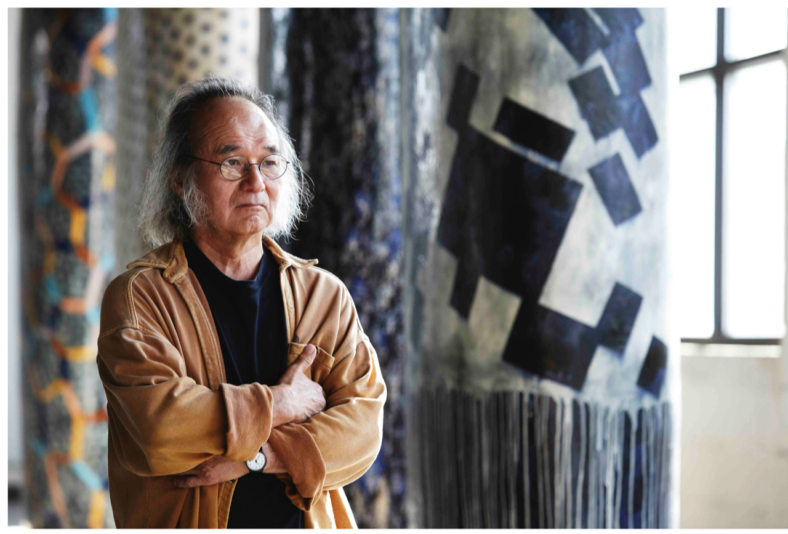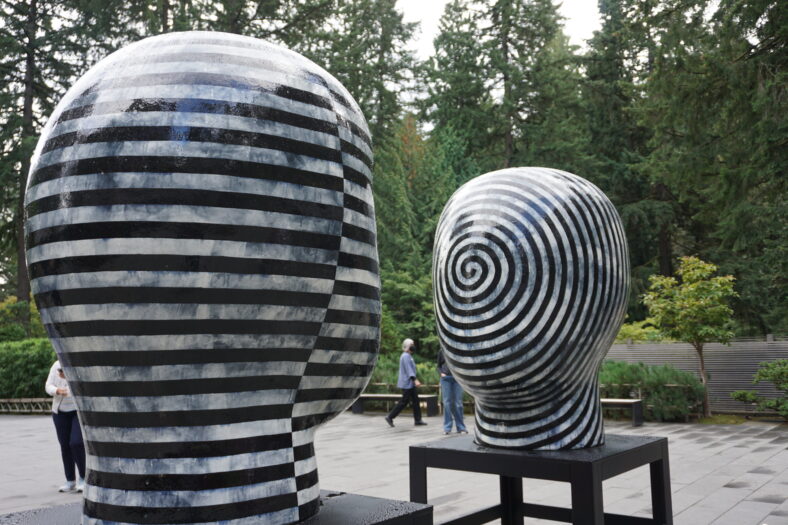
Portland Japanese Garden is excited to share that its final art exhibition of 2022 features the work of internationally acclaimed artist Jun Kaneko (b. 1942). Kaneko, winner of the prestigious Lifetime Achievement Award from the International Sculpture Center, has made major contributions to the field of sculptural art on a global scale, exploring the relationships between art, nature, and people with their bold scale and placement. The current art exhibition, Garden of Resonance: The Art of Jun Kaneko, presents a key selection of his mesmerizing, otherworldly sculptures merged into the Garden’s spaces, along with a collection of his smaller works on display in the Pavilion Gallery.
From Nagoya, Japan to California and eventually Nebraska— Jun Kaneko’s life is as layered as his work as an artist. In 1963, with aspirations to become a painter, Kaneko packed his bags and bought a one-way ticket for Los Angeles. Brazen and determined, not knowing the language and without enough cash to purchase a return flight, Kaneko embarked on an odyssey that would shape his artistic trajectory and personal destiny. Still fresh in Los Angeles, Kaneko was introduced to the California Clay Movement. Through seeing, touching, and rearranging ceramic sculptures, his interest in the possibilities of clay was ignited. After a motley education in clay arts, Kaneko went on to teach, exhibit and participate in artist residencies across the globe.

In 1982, on the invitation of Ree Schonlau, Kaneko was invited to a workshop in Omaha, Nebraska. Using an industrial-grade beehive kiln on the grounds of Omaha Brickworks, Kaneko began to experiment with giant, hand-built, clay structures. Since his first large scale commission in Omaha in 1983, Kaneko’s work has delighted people in several American cities as well as locations around the world.
Jun Kaneko eventually settled in Omaha, a place that enabled him to produce on a large scale with few interruptions. With the vision and guidance of Ree, who married Jun and was at the vortex of his career and evolution as an artist and creative brand, the Kanekos have had an unparalleled impact on the city’s community. They’ve created studio and exhibition spaces, established residency programs, and founded KANEKO, a creativity center to inspire future generations.

Walking through Portland Japanese Garden, a space that is at once familiar and filled with a sense of exploration, Jun Kaneko’s works accentuate the landscape. As you explore Garden of Resonance: The Art of Jun Kaneko , we invite you to consider the Japanese concept of ma ( 間 ), an awareness of space. Ma communicates a sense of place in respect to one’s relationship with the whole, making the space around and between things, the silent pauses in speech, or the negative space in a composition, important and meaningful. How does Garden of Resonance influence your experience of Portland Japanese Garden?
The Lines of Jun Kaneko

Lines are ever-present in Kaneko’s work. On permanent display in the Jordan Schnitzer Japanese Arts and Learning Center are a series of Kaneko’s wall tiles, a gift from Portland’s Bullseye Glass Company (above). Individually, each tile is an abstract work of art, but in combination they take on the role of an almost site-specific installation that transcends its parts. Kaneko likens the rigid yet organic lines that define some of his work to the ridges of a Japanese rock garden. The tiles together create a feeling of looking at the ripples of a quiet ocean or call to mind the surface of the Sand and Stone Garden.
As described by Dr. Frank Feltens, Japan Foundation Associate Curator of Japanese Art at Freer Gallery of Art and Arthur M. Sackler Gallery, the Smithsonian’s National Museum of Asian Art.